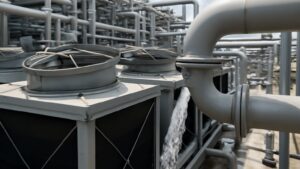High-stakes battery production relies on precision and reliability. The complex combination of advanced technologies and a strong supply chain is important in this area. However, the supply chain challenges of ensuring a smooth flow of specialized battery manufacturing equipment have been getting tougher with the soaring global demand for batteries driven by surging electric vehicles and renewable energy storage solutions.
Battery manufacturing is supported by an interlocking system of suppliers, logistics providers, and stakeholders spread across the globe that provide intricate machinery, precision components, and advanced materials. The smallest disruption in this fragile ecosystem can have far-reaching consequences such as slowing down production lines, compromising quality standards, or even impacting the capacity to meet the continuously increasing demand for high-performance batteries.
In this article, we take a deeper look into the fascinating sphere of battery machinery supply chains and consider the problems they bring to manufacturers, as well as the creative solutions employed by those same manufacturers to successfully address these supply chain challenges. Starting from handling scarcity of resources and trading issues up to creating strong alliances with other organizations and fully integrating technology tools, we unveil some remarkable strategies that facilitate flexibility and adaptability among such vital supply chains, ensuring their continuity.
The Global Landscape: Mapping the Supply Chain Challenges
The supply chain for battery manufacturing is truly a global endeavor. It comes with components and materials being sourced from various parts of the world. This extensive dispersion brings forth innumerable difficulties, each defined by its distinctive subtleties and intricacies.
Geopolitical Shifts and Trade Dynamics
To continue to keep pace with shifting geopolitics and trade dynamics, reconstituting alliances, as well as always-transforming regulations, battery producers must keep their eyes peeled. This is for any indication that things are about to change. So, this might involve new tariff rules, sanctions on countries, or variations in the agreement of trade that could disturb their well-established distribution chains. It requires companies to reevaluate sourcing strategies and investigate new potential suppliers or markets.
Additionally, the increasing focus on homegrown manufacturing and strengthening the supply chain in different parts of the world has pushed gigafactories to increase diversity among suppliers and to build relationships with local providers in particular, while still maintaining a global presence. This is done to decrease vulnerabilities that may hamper operational sustainability.
Raw Material Scarcity and Supply Bottlenecks
Battery manufacturing equipment consists of delicate components and advanced materials. These are commonly obtained from finite natural resources. So, it exposes the system to supply bottlenecks and even shortages. Supply interruptions can come about as a result of many factors. It includes fluctuating mining output, environmental controls, governmental policies, as well as rivalries. In such instances, producers may be forced to explore other avenues or create substitutes.
To be efficient and successful, supply chain management in the given circumstances should entail the use of preemptive risk evaluation. It should also include the establishment of strategic stockpile levels, and nurturing diverse supplier relationships. It guarantees that a steady and unbroken flow of essential inputs can be maintained.
Logistical Challenges and Transportation Risks
The global nature of the battery manufacturing equipment introduces hurdles in logistics. It also gives risks of transportation inherently. So, from the congestion of ports and delays in shipping to the potential of cargo damage, the movement of these special machinery and sensitive components across a long distance is an endeavor that requires precaution.
As a result, manufacturers must carefully see their transportation models, routes, and partners for logistics. Moreover, they should implement contingency plans and strategies for risk mitigation. It ensures the timely and secure delivery of critical battery manufacturing equipment and materials are there.
Cybersecurity and Data Protection Concerns
The supply chain system is now increasingly digitalized. So, the risks of cyber threats and breaches of data cannot be ignored. Furthermore, sensitive information like IP, production schedules, and supply data can be open to malicious actors. They seek to disrupt these operations or even gain a competitive advantage over them.
Strong security measures are therefore crucial, and they include continual risk assessments, personnel training, and secure data transfer methods. It protects supply chain activities’ confidentiality and integrity. Additionally, it shields priceless goods from danger.
Strategies for Supply Chain Agility in Battery Manufacturing Equipment
Battery manufacturers have taken a lot of various strategies to fortify their supply chains against complex challenges. These have enhanced resilience and ensured that business continues in the ever-changing landscape.
Strategic Partnerships and Ecosystem Collaboration
One of the most powerful approaches is building strategic partnerships and collaborative ecosystems. This close relation with key suppliers enables manufacturers to gain deep insights. This is into the trends emerging, potential disruptions, and also innovative solutions.
These partnerships often go beyond transactions. It evolves into collaborative efforts focused on joint research and development. It also involves shared risk mitigation strategies and the co-creation of sustainable supply chain practices. Additionally, Industry consortiums and cross-sector collaborations make these efforts even stronger. As a result, it allows for the exchange of best practices and the development of collective solutions to common supply chain challenges.
Digitalization and Supply Chain Visibility
Real-time data and advanced analytics are factors that drive decision-making today. This digitalization of supply chains has emerged as a great tool. This is for increasing visibility, agility, and also responsiveness. With the use of cutting-edge technologies like blockchain or IoT, gigafactories can enable insights into their operations of the supply chain.
Furthermore, tracking shipments in real-time, predictive maintenance of battery manufacturing equipment, and data-driven demand forecasting add to a more transparent supply chain. It also enables proactive decision-making and quick adaptation in the changing market.
Embracing Localization and Vertical Integration
Battery manufacturers have begun to explore the benefits of localization and vertical integration as supply chain resilience grows in importance. So, by bridging crucial components of the supply chain in-house or making local sourcing and manufacturing, companies can minimize their dependence on global networks of supply.
This approach can require major investments upfront and a shift in the operational models. However, it gives the potential of greater control reducing lead times. It also leads to a more secure supply of the essential materials. Additionally, localization can establish economic growth and the creation of jobs. It also falls within the broader goals of sustainability and the development of the community.
Battery Manufacturing Equipment: Quality Assurance and Compliance Of Supply Chain
Ensuring safety and optimal performance is vital in the battery manufacturing industry. Adhering to quality standards and regulations is crucial throughout the supply chain. Battery makers must navigate complex rules, certifications, and requirements. This guarantees product integrity and protects customers and stakeholders.
Stringent Testing and Validation Protocols
Every stage of the battery equipment supply chain undergoes rigorous testing and validation. Protocols cover aspects like raw material composition analysis, simulated performance evaluations, and compliance checks against industry standards and regulations. From initial components to finished products, comprehensive assessments take place to verify quality and safety.
Manufacturers often partner closely with certification bodies, third-party testing laboratories, and regulatory authorities. It ensures that their battery manufacturing equipment as well as the process meet the highest quality and benchmarks of safety. Moreover, this commitment to assurance of quality not only enhances the reliability of the product but builds consumer trust and confidence in the industry.
Traceability and Supply Chain Transparency
Transparency and teachability across the supply chain are now two core pillars. It sustains the regulatory compliance and practices of ethical sourcing. Gigafactories are putting sophisticated tracking and reporting systems to track the origin of materials/ components to ensure this compliance.
Furthermore, beyond just adherence to regulations, this commitment to transparency gives stakeholders and customers the reassurance of buying items that are ethical and sustainable. So, manufacturers can improve their image and foster a more sustainable business by adopting such transparency.
Conclusion
The gigafactories stand at the front of the revolution to bring sustainable energy solutions as the world moves toward this transition. It focuses on driving innovation and powering the technologies that will shape our future. However, its success depends on the resilience and agility of supply chains. They are at the core of supporting battery manufacturing equipment.
To navigate through the challenges, proper management is required. The article covers some strategies to achieve that, however, collaboration, partnerships, and insights prove to be the most powerful. This is where The Global Summit on Gigafactory Design and Construction, taking place on April 18-19, 2024, in Berlin, Germany presents a unique opportunity. The summit focuses on bringing together industry leaders, experts, and innovators who are at the forefront of gigafactory design, construction, and management. So, the summit brings valuable insights, case studies, and networking sessions to ensure your operations are future-proof. So, what are you waiting for? Register today!





